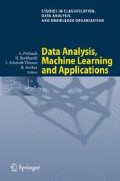Abstract
In the last decade the classifier ensembles have enjoyed a growing attention and popularity due to their properties and successful applications.
A number of combination techniques, including majority vote, average vote, behaviorknowledge space, etc. are used to amplify correct decisions of the ensemble members. But the key of the success of classifier fusion is diversity of the combined classifiers.
In this paper we compare the most commonly used combination rules and discuss their relationship with diversity of individual classifiers.
Access this chapter
Tax calculation will be finalised at checkout
Purchases are for personal use only
Preview
Unable to display preview. Download preview PDF.
References
CUNNINGHAM, P. and CARNEY J. (2000): Diversity versus quality in classification en-sembles based on feature selection, In: Proc. of the European Conference on Machine Learning, Springer, Berlin, LNCS 1810, 109-116.
DIETTERICH, T.G. (2000): Ensemble methods in machine learning, In: Kittler J., Roli F. (Eds.), Multiple Classifier Systems, Springer, Berlin, LNCS 1857, 1-15,
DOMINGOS, P. and PAZZANI, M. (1997): On the optimality of the simple Bayesian classifier under zero- loss, Machine Learning, 29, 103-130.
DUIN, R. (2002): The Combining Classifier: Train or Not to Train?, In: Proc. of the 16th Int. Conference on Pattern Recognition, IEEE Press.
GATNAR, E. (2005): A Diversity Measure for Tree-Based Classifier Ensembles. In: D. Baier, R. Decker, and L. Schmidt-Thieme (Eds.): Data Analysis and Decision Support. Springer, Heidelberg New York.
GIACINTO, G. and ROLI, F. (2001): Design of effective neural network ensembles for image classification processes. Image Vision and Computing Journal, 19, 699-707.
GRABISCH, M. (1995): On equivalence classes of fuzzy connectives -the case of fuzzy inte-grals, IEEE Transactions on Fuzzy Systems, 3(1), 96-109.
HANSEN, L.K. and SALAMON, P. (1990): Neural network ensembles. IEEE Transactions on Pattern Analysis and Machine Intelligence 12, 993-1001.
HUANG, Y.S. and SUEN, C.Y. (1995): A method of combining multiple experts for the recog-nition of unconstrained handwritten numerals, IEEE Transactions on Pattern Analysis and Machine Intelligence, 17, 90-93.
KOHAVI, R. and WOLPERT, D.H. (1996): Bias plus variance decomposition for zero-one loss functions, In: Saitta L. (Ed.), Machine Learning: Proceedings of the Thirteenth In-ternational Conference, Morgan Kaufmann, 275- 283.
KUNCHEVA, L. and WHITAKER, C. (2003): Measures of diversity in classifier ensembles, Machine Learning, 51, 181-207.
KUNCHEVA, L., WHITAKER, C., SHIPP, D. and DUIN, R. (2000): Is independence good for combining classifiers? In: J. Kittler and F. Roli (Eds.): Proceedings of the First Inter-national Workshop on Multiple Classifier Systems. LNCS 1857, Springer, Berlin.
KUNCHEVA, L., BEZDEK, J.C., and DUIN, R. (2001): Decision Templates for Multiple Classifier Fusion: An Experimental Comparison. Pattern Recognition 34, 299-314.
PARTRIDGE, D. and YATES, W.B. (1996): Engineering multiversion neural-net systems. Neural Computation 8, 869-893.
PARTRIDGE, D. and KRZANOWSKI, W.J. (1997): Software diversity: practical statistics for its measurement and exploitation. Information and software Technology, 39, 707-717.
ROGOVA, (1994): Combining the results of several neural network classifiers, Neural Net-works, 7, 777-781.
SKALAK, D.B. (1996): The sources of increased accuracy for two proposed boosting algo-rithms. Proceedeings of the American Association for Artificial Intelligence AAAI-96, Morgan Kaufmann, San Mateo.
THERNEAU, T.M. and ATKINSON, E.J. (1997): An introduction to recursive partitioning using the RPART routines, Mayo Foundation, Rochester.
TUMER, K. and GHOSH, J. (1996): Analysis of decision boundaries in linearly combined neural classifiers. Pattern Recognition 29, 341-348.
WERNECKE K.-D. (1992): A coupling procedure for discrimination of mixed data, Biomet-rics, 48, 497-506.
Author information
Authors and Affiliations
Editor information
Editors and Affiliations
Rights and permissions
Copyright information
© 2008 Springer-Verlag Berlin Heidelberg
About this paper
Cite this paper
Gatnar, E. (2008). Fusion of Multiple Statistical Classifiers. In: Preisach, C., Burkhardt, H., Schmidt-Thieme, L., Decker, R. (eds) Data Analysis, Machine Learning and Applications. Studies in Classification, Data Analysis, and Knowledge Organization. Springer, Berlin, Heidelberg. https://doi.org/10.1007/978-3-540-78246-9_3
Download citation
DOI: https://doi.org/10.1007/978-3-540-78246-9_3
Publisher Name: Springer, Berlin, Heidelberg
Print ISBN: 978-3-540-78239-1
Online ISBN: 978-3-540-78246-9
eBook Packages: Mathematics and StatisticsMathematics and Statistics (R0)

